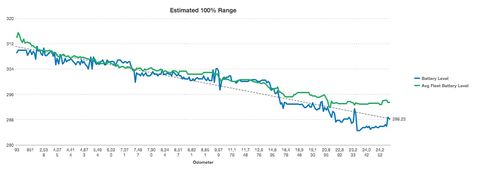
Michael SimariCar and Driver
- Battery packs in electric vehicles slowly lose capacity to store energy over time.
- Our long-term Tesla Model 3 has so far lost 7 percent of its capacity over 24,000 miles.
- All EVs have lengthy warranties on the battery pack to assuage buyers' potential fear of expensive replacement costs.
Much like the little lithium-ion pack in your cell phone, the battery in an EV slowly loses its ability to store energy over time. In the case of an electric car, this degradation in its total energy capacity means that its maximum range shrinks over time. There are many factors that play into this. Some are choices by the various automakers (such as how much of the battery's total capacity to make available; narrower swings in the state of charge are friendlier to longevity) and some based on the owner's behavior. For example, our long-term Tesla Model 3 specifies that charging above 90 percent shouldn't be done for daily use, only for trips, although it doesn't explicitly say what the long-term ramifications might be for regularly going above that threshold.
We were of course curious to see how our car's pack is faring over time, and the geektastic TeslaFi software we've used to track our car's more than 24,000 miles and each of the 842 times we've plugged it in has an answer. (Seriously, if you have a Tesla, sign up for TeslaFi.)
TeslaFi's battery-tracking tool puts our pack at 93 percent of its original 75.0-kWh capacity, a loss of about 22 miles of rated range from the original 310-mile EPA combined figure. This is based on the range data from the nearly 500 times we've charged our car to 90 percent of its capacity or above (see graph below). In cases where we charged to less than 100 percent, which is the vast majority, TeslaFi does a linear extrapolation to arrive at the predicted range at 100 percent (e.g., if the battery is charged to 90 percent and the range figure is 270 miles, the extrapolated 100 percent range figure = 270 / 0.9 = 300). Compared to 158 other Model 3s at similar mileage that are also connected to TeslaFi, our car is faring worse than 123 of them and better than 35.
We're not too surprised that we're doing worse than average, as fast charging at Tesla's Superchargers is not great for maximizing the battery's life, and we've gotten fully a third of the energy our car has used that way. Supercharging also costs about twice as much per kilowatt-hour of energy than charging at home.
Our battery's degradation thus far equates to a drop of roughly 2.9 percent in pack capacity every 10,000 miles, which, if it continues at this rate, would put us at 65 percent capacity at 120,000 miles. That's under the 70-percent-capacity retention specified in Tesla's eight-year/120,000-mile battery warranty for the Model 3 Long Range. However, Tesla makes it clear that in the case of a warranty claim, the car won't necessarily get a new battery, but one that at least meets the minimum 70 percent threshold.
We'll continue to watch this battery degradation trend and let you know where our pack ends up at the end of our 40,000-mile test.
This content is imported from {embed-name}. You may be able to find the same content in another format, or you may be able to find more information, at their web site.
This content is created and maintained by a third party, and imported onto this page to help users provide their email addresses. You may be able to find more information about this and similar content at piano.io
Bagikan Berita Ini

















0 Response to "Our Tesla Model 3 Has Lost 7 Percent of Battery Capacity in 24,000 Miles - Car and Driver"
Post a Comment